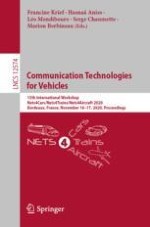2020 | Book
Communication Technologies for Vehicles
15th International Workshop, Nets4Cars/Nets4Trains/Nets4Aircraft 2020, Bordeaux, France, November 16–17, 2020, Proceedings
Editors: Francine Krief, Hasnaâ Aniss, Léo Mendiboure, Prof. Serge Chaumette, Dr. Marion Berbineau
Publisher: Springer International Publishing
Book Series : Lecture Notes in Computer Science

